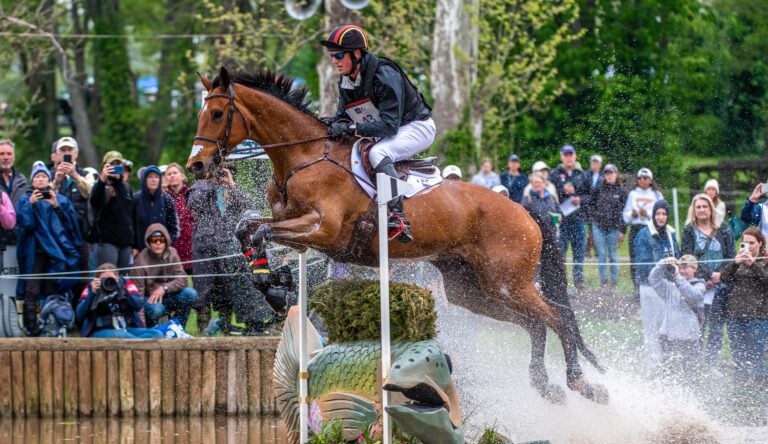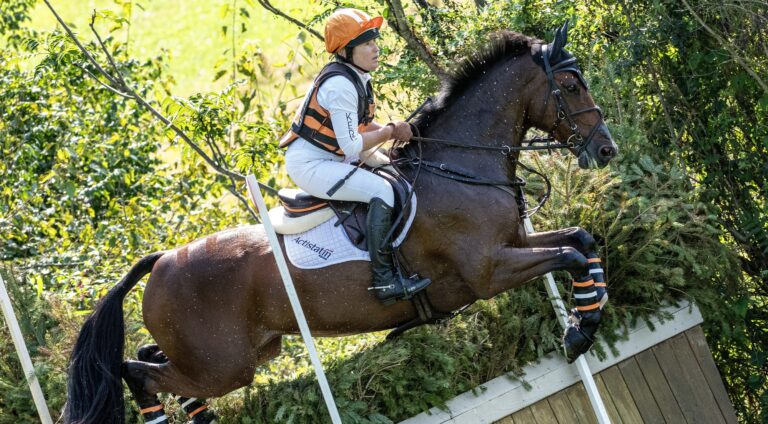Yachting and the equestrian sport of jumping don’t seem to have much in common, yet they often attract the same people. Marshall Field VI is a case in point. In carrying on his family’s long history with horses and boating, he has galloped down to and leaped over a 7-foot-four “Puissance” wall on horseback and cruised the Bahamas and elsewhere aboard his 72-foot Burger Motor Yacht.
 Marshall Field’s 72-foot Burger Motor Yacht | Photo Courtesy Marshall Field
Marshall Field’s 72-foot Burger Motor Yacht | Photo Courtesy Marshall FieldThe first takes absolute concentration; the latter an absolute lack thereof—at least once you’ve dropped anchor. Perhaps that’s the connection, the intensity of the one requires the relaxation of the other.
A counterbalance to the hectic highs of the jumping world may be more important in Marshall’s life because his wife, Tiffany Marr, DVM, is an accomplished jumper, too. She’s an even more accomplished veterinarian whose equine sports medicine expertise puts her in round-the-clock demand from the Wellington, Florida, competition circuit not far from their home in Hobe Sound.
 The Bahamas’ Exumas and Abaco islands are Marshall’s favorite destinations for quick getaways | Photo Courtesy Marshall Field
The Bahamas’ Exumas and Abaco islands are Marshall’s favorite destinations for quick getaways | Photo Courtesy Marshall Field“Cruising is a great way to get away and take a deep breath,” says Marshall. “You are relaxed and completely separated from everything else.”
The Bahamas’ Exumas and Abaco islands are favorite destinations for quick getaways. Marshall and Tiffany eschew marinas in favor of quiet, remote anchorages. “There’s nothing like that tranquility of the waves lapping against the hull.” Stand-up paddling through the cays, fish of all kinds and colors float far beneath the surface yet are easy to see and follow through crystal clear, sapphire hued waters. “I’d say it’s the antithesis of the horse experience,” Marshall observes.
A bit the Renaissance man, Marshall counts professional horsemanship among his careers. He hasn’t ridden professionally for a few years now, but enjoys doing so for fun and helps Tiffany and his daughter Chloe with their equestrian pursuits whenever needed.
 Marshall regularly competed in grand prix competition in the 1980s where he was one of very few amateurs competing against professionals including Olympians Michael Matz and Conrad Homfeld | Photo Courtesy Marshall Field
Marshall regularly competed in grand prix competition in the 1980s where he was one of very few amateurs competing against professionals including Olympians Michael Matz and Conrad Homfeld | Photo Courtesy Marshall FieldNot everybody gets the nuances and difficulties of jumping, but thankfully, many of the couple’s cruising friends hail from the horse world. For those who don’t, Marshall likes an analogy offered by his friend and mentor, the late Bob Akin, a champion racecar driver. “He told me, ‘I can’t believe what you people do with these horses. It’s just amazing, why do you do it?’ And this is from a guy who drove the Le Mans 24-hour race, going 240 miles per hour all night in the rain.
“Akin said that, in a race car, everything you do gets a planned reaction. You step on the brakes and you slow down. A horse is a race car with an opinion.”
That’s why it’s rare to see unbroken win streaks, even among the sport’s top combinations. Olympians McLain Ward and Sapphire or Eric Lamaze and Hickstead didn’t win every weekend, whereas you’ll see long success streaks with a talented car driver because their equipment produces repeatable results. With riding, there’s no such thing.
 Marshall hasn’t ridden professionally for a few years, but enjoys doing so for fun and helps his wife and daughter with their equestrian pursuits | Photo © Sportfot
Marshall hasn’t ridden professionally for a few years, but enjoys doing so for fun and helps his wife and daughter with their equestrian pursuits | Photo © SportfotOne similarity between boating and jumping serves Marshall’s admittedly “control freak” nature. “To me, it’s all about preparation. Anytime anyone has a result that you are not expecting, I feel like the preparation wasn’t adequate. You shouldn’t be surprised in a negative way very often and, if you are, you need to change your program. Riding is risky, but I think you can mitigate that with the right preparation.”
Marshall’s competitive equestrian days were dominated by “regular” grand prix competition—nothing to sneeze at with fence heights nearing six-feet and courses designed to test the fine calibration of gears trained into horses over many years. Grand prix competition was different in Marshall’s heyday in the 1980s. He was one of very few amateurs competing against professionals including Olympians Michael Matz and Conrad Homfeld. “I didn’t have any delusions about beating them on a regular basis,” but he was consistently a top finisher. “It was a very different dynamic back then and I felt honored to be riding against them.”
What overlap exists between boating and equestrian sports has much to do with socio-economic status and family traditions. Marshall’s great grandfather, Marshall Field III, played polo and passed the equestrian gene along. He often commuted between the North Shore of Long Island and Wall Street on “consolidated commuters.” These boats were equal parts efficient transportation and luxury back in the 1930s when cars were slower and roads were worse.
Marshall VI’s mother, Bitsy Tatnall, was an avid foxhunter and he took up the sport early at Toppings Riding Stable in South Hampton.
Now a broker for Rockport, Maine-based Yachting Solutions, he rides at home and enjoys keeping his hand in equestrian sport without competing. As a broker, he specializes in sport fishing boats and motor yachts in the 70-foot-plus range. His focus is the whole Eastern Seaboard and he keeps a somewhat amused eye on trends in the highest end of the industry: like privately-owned 500-foot “ships” with pads for a seaplane, helicopter and other toys. His Burger was the very latest in luxury and length back in the day, “but now it could be a tender for one of those boats!”
“Boating is an outdoor experience,” Marshall concludes. “You’re going to get hit with some sea spray.” If the master suite is 100 feet above the water, owners stay dry, but it’s a different experience. The majority of jumping is also an outdoor sport, but the Longines FEI World Cup™ North American League offers the added appeal of mostly indoor competitions. The arenas are smaller, the turns are tighter and there’s little time to make adjustments from one fence to the next.
“Show jumping is an exciting sport,” Marshall asserts. “At the end of the day, you are coaxing a 1,200-pound animal into doing what you want.” If it’s the aforementioned Puissance wall, at 7-foot-four-inches—eight inches taller than LeBron James—that means horse and rider are running down to a solid wall with no view of what’s on the landing side. It’s made of light wooden bricks, of course, so a knocked block is only fatal to a victory, but it’s a unique endeavor. “It’s bizarre,” Marshall admits. “It takes a very bold horse with a lot of power.”
Although the Longines FEI World Cup™ Jumping North American League adheres to more “normal” grand prix courses of 10 to 15 obstacles, it requires the same of the horses and their riders and it reliably produces spectacular sport.










